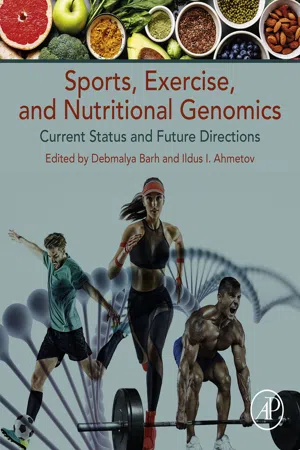
Sports, Exercise, and Nutritional Genomics
Current Status and Future Directions
Debmalya Barh,Ildus I. Ahmetov
- 606 pages
- English
- ePUB (mobile friendly)
- Available on iOS & Android
Sports, Exercise, and Nutritional Genomics
Current Status and Future Directions
Debmalya Barh,Ildus I. Ahmetov
About This Book
Sports, Exercise, and Nutritional Genomics: Current Status and Future Directions is the first reference volume to offer a holistic examination of omics-driven advances across different aspects of exercise and sports physiology, biochemistry, sports medicine, psychology, anthropology, and sports nutrition; and highlighting the opportunities towards advance personalized training and athlete health management. More than 70 international experts from 14 countries have discussed key exercise and sport-related themes through the prism of genomics, epigenomics, transcriptomics, proteomics, metabolomics, telomere biology, talent in sport, individual differences in response to regular physical activity, that in the future may empower coaches, sports physicians, fitness experts, genetic counselors, and translational scientists to employ various omics data and approaches in improving health and physical performance of people participating in sports and exercise activities.
Contributors address current knowledge of genetic influence on athletic performance, individual responses to exercise training, as well as the genetics of musculoskeletal phenotypes, exercise-related injuries, flexibility, and neurodegenerative disorders in athletes.
Finally, performance-related and psychological traits associated with epigenetic, transcriptomic and metagenomic biomarkers are also considered, along with nutritional and pharmacogenomic aids in sports medicine and personalized nutrition.
- Effectively synthesizes key themes across molecular aspects of exercise and sports sciences
- Provides a knowledge base for future translation of omics solutions to talent identification, individualized training, and nutrition
- Features contributions from international experts (researchers and clinicians) in the subject area
Frequently asked questions
Information
Introduction to genetics of sport and exercise
b School of Health Sciences, European University, Madrid, Spain
Abstract
Keywords
1.1 Nature vs nurture influence
Table of contents
- Cover image
- Title page
- Table of Contents
- Copyright
- Contributors
- About the Editors
- Preface
- Section I: Sports genetics
- Section II: Exercise genetics and molecular physiology
- Section III: Genetics of musculoskeletal exercise-related phenotypes
- Section IV: Genetics of sport-related diseases and medical conditions
- Section V: Nutrigenetics, pharmacogenetics and metabolomics in sport and exercise
- Index